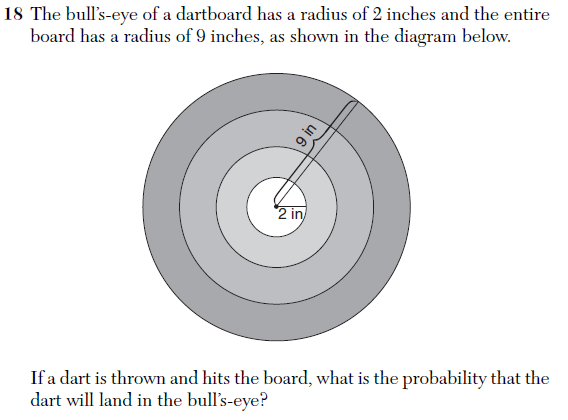Regents Recap — June 2012: Throwing Darts
Here is another installment from my review of the June 2012 New York State Math Regents exams.
Below is a problem from the Integrated Algebra exam that highlights the artificiality of so-called “real world” problems.
In order to solve this problem in a high school algebra class, a crucial assumption must be made, namely, that every point on the target is equally likely to be hit. This means that the dart is just as likely to hit a spot near the bulls-eye as any spot near the edge.
Math teachers end up spending a lot of time training students to make these assumptions, probably without ever really talking explicitly about them. It’s not necessarily bad that we make such assumptions: refining and simplifying problems so they can be more easily analyzed is a crucial part of mathematical modeling and problem solving.
What’s unfortunate is that, in practice, students are kept outside this decision-making process: how and why we make such assumptions isn’t emphasized, which is a shame, because exploring such assumptions is a fundamental mathematical process.
Is it a reasonable assumption that every point is equally likely to be hit? Well, if the thrower is skilled, the dart is probably more likely to land near the bulls-eye. Would gravity make the lower-half more likely than the upper half? Discussing these, and other relevant factors as part of the modelling process can be engaging, fun, and highly mathematical.
But when standardized tests with “real world” problems are the focus of education, students usually end up getting trained to not ask these questions.

6 Comments
Curmudgeon · August 20, 2012 at 6:27 pm
Not to mention the fact that a central spot radius of 2 means that the outer rings are 7/3 inches “wide” – very unlikely. The radius of the board should have been 8″.
MrHonner · August 22, 2012 at 6:57 am
Nice catch. I didn’t even notice that.
Laura Laing · August 24, 2012 at 6:47 am
Excellent point. I’ve written this example (or ones like it) many times (at the bequest of a publisher or content developer), and it always bugged me. What if we had a robot shooting the arrow randomly? Not so real-world, eh? *smile*
Great post.
Laura
MrHonner · August 24, 2012 at 7:41 am
Thanks for sharing, Laura.
It’s not even really the problem that bothers me here, but rather the cumulative effect this has on the classroom and on student learning.
Problems (and tests) like these train students to stop asking questions (like, “How many ways can you arrange books on a shelf?“). That is not what ‘education’ should do.
Ravi · August 24, 2012 at 2:20 pm
I agree totally with what you are saying. The question could be improved by doing the following.
Part A – assume the dart has an equal but random chance of landing on any part of the board and then calculate the probability
Part B – List at least four reasons why the assumption in part A might be wrong?
You could give say 80% of the marks for part A and 20% for part B. So the student with a broader understanding can demonstrate it.
MrHonner · August 25, 2012 at 8:02 am
That’s a great idea. Not only does this demand some higher-level thinking, but it also makes the student explicitly aware that there are limitations to the given model.
Also the new “Common Core Standards” that are being adopted here really emphasize writing and explaining process, and I think this fits right in.